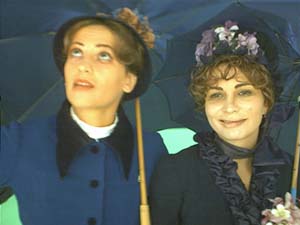In her films about Chagall, Renoir and Rousseau, Groo creates an imaginary exhibition, where several of the respective artist’s paintings from various museums and collections throughout the world are hung side by side. The camera focuses on each of the works in turn, wherefrom the painted figures emerge, enacted by living actors. These figures start to interact and conduct dialogues that Groo puts in their mouths. The artist himself appears amidst the figures, taking part in the plot, thus lending the film an autobiographical dimension.
The style of each film is derived from the style of the artist who is its subject. Thus, the film about Henri Rousseau (‘Le Douanier’) assumes a fantastic, illusory, near-surreal nature, featuring the old, clever moon seen above, the exotic jungle, French and English football players, and strange yet friendly snake tamers. The text accompanying the film is poetic, as befitting the dreamy nature of the work.
Groo puts totally different texts in the mouths of the figures in her film about Renoir. These are, of course, mostly women. Renoir’s models are simple, hard-working girls, wretched seamstresses who dream of a glamorous life. The simple, concrete texts in their mouths attest to their simple world where everyone gossips about, envies, lusts for, tempts, fights with, and loves everyone.
Unlike her other films, Groo’s film about Pieter Bruegel (the Elder) is based on a single painting, Netherlandish Proverbs (1559, Staatliche Museen, Berlin). Bruegel’s scholars have noted the fact that each scene in this painting depicts a different Flemish proverb. These are divided into two groups: proverbs describing the absurdity and lack of common sense with which human logic is sometimes inflicted, and others addressing sinful, morally corrupt behavior. The dialogues Groo puts in her actors’ mouths generate a narrative that interprets the proverbs, elucidating the work’s iconography for the viewer.
Less Reading...
